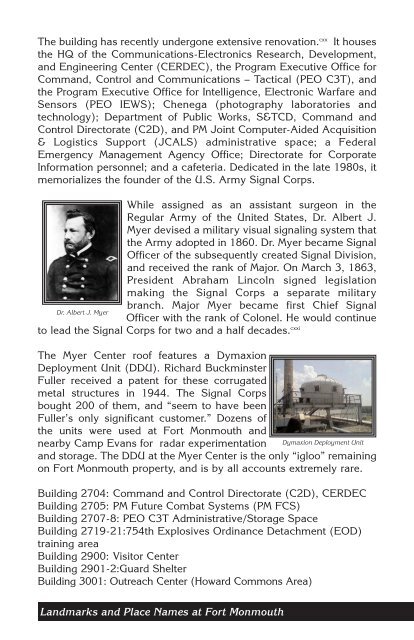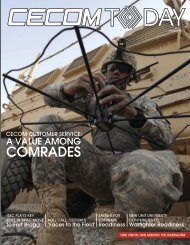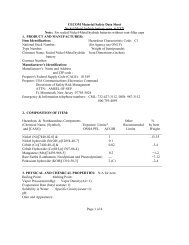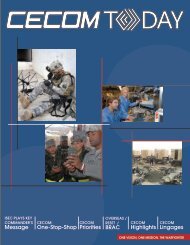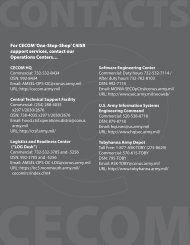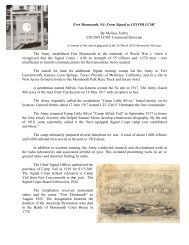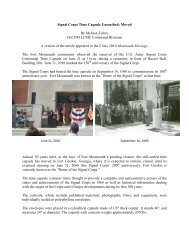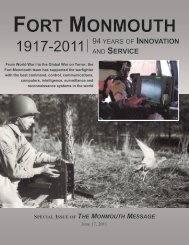Landmarks, Memorials, Buildings and Street Names of ... - CECOM
Landmarks, Memorials, Buildings and Street Names of ... - CECOM
Landmarks, Memorials, Buildings and Street Names of ... - CECOM
- No tags were found...
Create successful ePaper yourself
Turn your PDF publications into a flip-book with our unique Google optimized e-Paper software.
The building has recently undergone extensive renovation. cxx It housesthe HQ <strong>of</strong> the Communications-Electronics Research, Development,<strong>and</strong> Engineering Center (CERDEC), the Program Executive Office forComm<strong>and</strong>, Control <strong>and</strong> Communications – Tactical (PEO C3T), <strong>and</strong>the Program Executive Office for Intelligence, Electronic Warfare <strong>and</strong>Sensors (PEO IEWS); Chenega (photography laboratories <strong>and</strong>technology); Department <strong>of</strong> Public Works, S&TCD, Comm<strong>and</strong> <strong>and</strong>Control Directorate (C2D), <strong>and</strong> PM Joint Computer-Aided Acquisition& Logistics Support (JCALS) administrative space; a FederalEmergency Management Agency Office; Directorate for CorporateInformation personnel; <strong>and</strong> a cafeteria. Dedicated in the late 1980s, itmemorializes the founder <strong>of</strong> the U.S. Army Signal Corps.While assigned as an assistant surgeon in theRegular Army <strong>of</strong> the United States, Dr. Albert J.Myer devised a military visual signaling system thatthe Army adopted in 1860. Dr. Myer became SignalOfficer <strong>of</strong> the subsequently created Signal Division,<strong>and</strong> received the rank <strong>of</strong> Major. On March 3, 1863,President Abraham Lincoln signed legislationmaking the Signal Corps a separate militarybranch. Major Myer became first Chief SignalDr. Albert J. MyerOfficer with the rank <strong>of</strong> Colonel. He would continueto lead the Signal Corps for two <strong>and</strong> a half decades. cxxiThe Myer Center ro<strong>of</strong> features a DymaxionDeployment Unit (DDU). Richard BuckminsterFuller received a patent for these corrugatedmetal structures in 1944. The Signal Corpsbought 200 <strong>of</strong> them, <strong>and</strong> “seem to have beenFuller’s only significant customer.” Dozens <strong>of</strong>the units were used at Fort Monmouth <strong>and</strong>nearby Camp Evans for radar experimentation Dymaxion Deployment Unit<strong>and</strong> storage. The DDU at the Myer Center is the only “igloo” remainingon Fort Monmouth property, <strong>and</strong> is by all accounts extremely rare.Building 2704: Comm<strong>and</strong> <strong>and</strong> Control Directorate (C2D), CERDECBuilding 2705: PM Future Combat Systems (PM FCS)Building 2707-8: PEO C3T Administrative/Storage SpaceBuilding 2719-21:754th Explosives Ordinance Detachment (EOD)training areaBuilding 2900: Visitor CenterBuilding 2901-2:Guard ShelterBuilding 3001: Outreach Center (Howard Commons Area)<strong>L<strong>and</strong>marks</strong> <strong>and</strong> Place <strong>Names</strong> at Fort Monmouth


